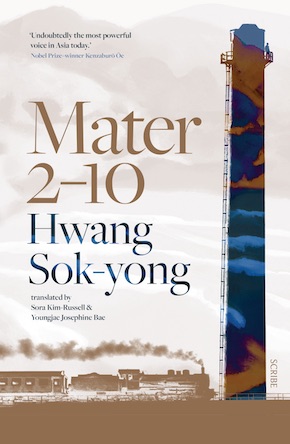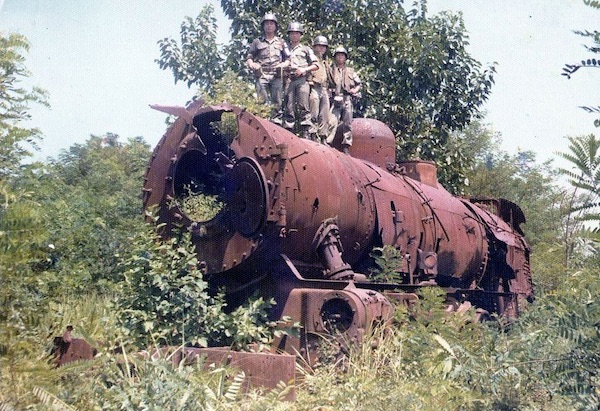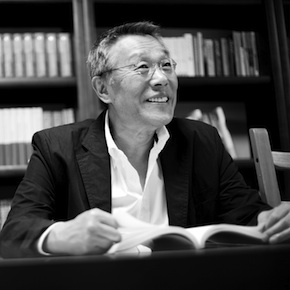History train
by Hwang Sok-yong
‘Mater’ comes from the Japanese abbreviation for ‘mountain’. During Japanese colonialism, fifty Mater 1 locomotives, modelled after their Mountain-type counterparts in the United States, were built in Gyeongseong (Seoul) and at the Kisha Seizo factory in Japan. The thirty-three-carriage Mater 2, an improved version manufactured by Kawasaki Heavy Industries, was introduced and operated mainly in North Korea. Mater 2-10 was a locomotive from this line that was captured during the Korean War by the South Korean army as they advanced north. It was originally used between Gaeseong and Pyeongyang, but ended up at Jangdan Station, south of Gaeseong, when the Allies were retreating. Then, on 31 December 1950, the US Army destroyed it to keep it out of enemy hands. For a long time, it sat abandoned and rusting like an empty tin can in the Demilitarized Zone (DMZ) between North and South, where it came to be known by the nickname Hwatong, or Smokestack. As part of the modern cultural-heritage restoration project, it was retrieved in 2004, repaired over a period of two years, and exhibited at Imjingak in Unification Park as National Registered Cultural Heritage No. 78. Behind a sign that reads ‘This iron horse wants to run!’, the rusted-out shell of the locomotive faces north. Mater 2-10 is an enduring image of the Korean War that has since appeared in textbooks, newspapers, magazines, government brochures, and even its very own postage stamp. The remains of this old metal hulk have changed meaning with each change of era and government administration amid the dualities of the Cold War and anti-communism, peace and reconciliation. Like a mummy in a tomb, Mater 2-10 has been chemically preserved and turned into a commemorative fossil of the age of division.
—
This novel was born from a conversation I had with an old man in Pyeongyang during my visit to North Korea in 1989. At the Pyeongyang Department Store, a destination recommended by the authorities, I exchanged greetings with the general manager and was introduced to the assistant manager who would be giving me a tour. Rumour had it that the general manager had played a major role in supplying daily necessities to a certain area during the Korean War, so I suspected that the reason the assistant manager had held his position until well into his old age was that he had also proven his abilities somehow in distribution or transportation.
I noticed that the man spoke in Seoul dialect. On top of which, the cadence of his speech and the words he used were old-fashioned. I couldn’t help but ask where he was born, and when he said Seoul, I had to ask where in Seoul, to which he said Yeongdeungpo. Yeongdeungpo District was where I’d grown up. My family had settled there after leaving Pyeongyang and crossing the 38th parallel in 1947. Instead of admiring the goods on display as we roamed about the department store, we spent most of our time talking about what Yeongdeungpo used to be like. We bonded over our memories of the district. We had shared the same space and time: I, a boy who had just started primary school; he, a train engineer who belonged to the National Council of Labour Unions. One time, a colonial-era school building located somewhere between his old neighbourhood and mine caught fire. The wooden building burned all the way down to the toilets, leaving behind a stench that filled the air in both of our neighbourhoods for days. We remembered it like it was yesterday and delighted over the shared memory.
A few days later, after pleading to my guides, I was allowed to meet him again; we shared soju at a fish market along the Daedonggang River. He told me all about how his father had worked at the Yeongdeungpo Rail Works, how he got accepted into the training school for rail workers, and all the things he saw while driving trains along the continental route. The scenes he described from memory were lyrical and moving: the red sun as big as a washbasin going down over the endless black fields of Manchuria; seas of sorghum rippling in the wind; snowflakes the size of a child’s head filling the sky and cascading down to the ground; the beautiful mountains, rivers, and valleys of Joseon; rural train stations standing in empty fields. After Liberation, when the US Army Military Government in Korea cracked down on the National Council of Labour Unions, my guide fled to the North with his own son. With the outbreak of the Korean War, his teenage son, who had just completed an intensive course for train engineers, was put to work transporting war supplies to the Nakdonggang River front, from which he never returned. Thirty years now have passed since I met that old man and listened to his stories, thirty years during which I kept trying to write this book only to give up or put it off for later. Judging from how old he was when I met him, he must have passed away by now.
While undergoing our long period of division, it has never been easy to argue for North Korea’s national legitimacy; meanwhile, the people of South Korea gained their legitimacy through blood, sweat and tears.”

In reading Korean literature widely over the years, I couldn’t help but notice what was missing. Namely, in both quality and quantity, short fiction has tended to outperform long fiction, very little of which in turn depicts the lives of modern industrial workers. Even the few works left behind by the colonial-era Korean Proletarian Artists’ Federation were mostly short fiction focused on the urban poor, day labourers, or the ‘lumpenproletariat’, so it’s not an exaggeration to say that there were no full-length novels that featured industrial workers as the main characters. Even among recent novels, most in this vein have centred on farmers.
Over the course of my research, it occurred to me that it seemed only natural that socialism would become the ideological root of the labour movement under Japanese colonialism and beyond. After Liberation and national division, workers who fought for their right to live were denounced as communists. Then after the Korean War and the onset of the global Cold War, all labour movements were seen as seditious during the decades of developmental dictatorship that followed. While undergoing our long period of division, it has never been easy to argue for North Korea’s national legitimacy; meanwhile, the people of South Korea gained their legitimacy through the blood, sweat, and tears they shed in the process of becoming the subjects of modernisation, achieving industrialisation, and establishing a democratic system. But insofar as our system is still far from perfect, it may be best to refrain from debating legitimacy until the day the two Koreas become one again. If South Korea can overcome and make up for its shortcomings and equip itself with the capability to embrace North Korea and elicit change, that would probably be the right step toward a peaceful unification.
—
The railroad that once ran from the Korean peninsula to the rest of the Asian continent was a symbol of colonial modernity and imperialism. Global modernity itself practically began with the first railroad. In writing this book, I wanted to explore how the dreams of Korean labourers — who lived during a century or more of colonialism, division, and capitalist globalisation — were transformed and distorted. Labourers lost or hid their class consciousness, but their living conditions didn’t really change. My idea was to depict the lives of people as if in a dream. I wanted to create a ‘mindam’-style world centred on Yeongdeungpo with a plot built from personal, everyday anecdotes, rather than solely historical facts. Of course, historical facts still butted in now and then, but I approached the stories of anti-Japanese labour activists like tales from long ago. At times the book grows more serious, but in the end those tales of old have a way of gently wrapping their arms around the glaring light of facts, like a faded photograph or an antique. By bringing to the fore industrial workers who have been neglected from Korean literature, I sought to trace the journey they took over the past century and reveal the root of their lives today. My hope was to add another stone to the pillar of Korean literature that has weathered history’s stormy twists and turns. Some say today’s chaotic neoliberal world is in the middle of transitioning to a different order as the capitalist world-system heads toward collapse. Whether this period of suffering will be short or long is entirely up to the efforts of those of us living in the present. The traces of our lives and the time we lived in may be no more than a few specks of dust compared to the life of the vast universe. And though change happens slowly – very, very slowly – I don’t want to abandon my hope that it changes for the better.
This novel is both a story of my hometown, replete with childhood memories, and a story of the labourers who lived there.”
I received a great deal of support to write this story. I wish to thank the Korea Railroad Corporation (KORAIL) and the Yeongdeungpo District Office for providing me with sources, including A Hundred Years of the Korean Railroad (Korean National Railroad, 1999) and Records of Yeongdeungpo-gu (Yeongdeungpo-gu, 1999). Professor Kim Kyung-il’s work, The History of Labour Movements Under Japanese Colonial Rule (Changjakgwa bipyeongsa, 1992) and A Study on Yi Jaeyu (Changjakgwa bipyeongsa, 1993), proved to be invaluable in learning details about the lives and struggles of labourers under Japanese occupation. Gyeongseong Troika (Sahoe pyeongnon, 2004) and other works by Ahn Jae-seong were also quite helpful. There are many other sources, including A Historical Study of the Lives of the Poor Under Japanese Occupation (Changjakgwa bipyeongsa, 1995), that aided me along the way, but I’m afraid there’s not enough space here to list them all.
I would also like to express my gratitude to Cha Gwang-ho, a former branch chief of the Metal Workers’ Union whom I met through the poet Song Kyung-dong. Mr Cha had staged a chimney sit-in for 408 days and was kind enough to share the details of his experience with me, even showing me how he did his burpees. I’m also grateful to the Korea Train Express (KTX) engineer Son Min-du. He allowed me to join him in the driver’s cab, giving me an engineer’s-eye view of several different rail lines. He also introduced me to Kang Hye-jin, an elderly, retired train engineer from the time of steam locomotives, who kindly taught me all about the components of a steam locomotive and the techniques involved in driving one. Mr Kang even gave me several demonstrations at a locomotive exhibit and described in detail the working life of an engineer.
Last but not least, I’d like to express my gratitude to my friends in Iksan who helped me in more ways than one while I was working on this novel and the Won Buddhist cleric Seo Jong-myeong for taking such good care of me during my stay. I also send my appreciation to the editors at Changbi who supported my research for this project and cheered me on from the very beginning.
—
While writing the novel, I went for many strolls around the neighbourhood in Yeongdeungpo where I grew up. It’s the same with a lot of places on the edges of Seoul, but I would stumble upon these old alleyways and old buildings, and just have to stop and stand there for a while, studying the faces of people walking by, hoping to catch a familiar-looking one. Nearly forgotten memories came back to me then, and I saw my mother, sisters, younger brother, and even my father, who died young, in the alleys, the market, the spot where our house used to be, looking the same way they did back when we lived there.
Instead of the famous faces of Korean history that already star in countless texts, I modelled the characters in this book after the many workers who have been reduced to historical specks of dust. The activists who appear in these pages represent all the nameless workers who gave body and soul to the small parts they played. They were drawn from my imagination, but they can also be thought of as a composite of the numberless common folk whose names alone survive in police reports, court records, and other archives.
This novel is both a story of my hometown, replete with childhood memories, and a story of the labourers who lived there. I dedicate this novel to them, with hope that it will go towards filling the gap in Korean literature where their stories should be.
from the Author’s Note and Afterword to Mater 2-10 (Scribe, £16.99)
—

Hwang Sok-yong was born in 1943 and is arguably Korea’s most renowned author. In 1993, he was sentenced to seven years in prison for an unauthorised trip to the North to promote exchange between artists in the two Koreas. Five years later, he was released on a special pardon by the new president. The recipient of Korea’s highest literary prizes, his novel At Dusk was awarded the Emile Guimet Prize for Asian Literature and shortlisted for the 2019 Man Booker International Prize. His previous books include the novels The Ancient Garden, The Story of Mister Han, The Guest, The Shadow of Arms, Princess Bari, Familiar Things, and the memoir The Prisoner. Mater 2-10, translated by Sora Kim-Russell and Youngjae Josephine Bae, is published by Scribe in paperback and eBook.
Read more
@ScribeUKbooks
Sora Kim-Russell has translated numerous works of Korean fiction, including Hwang Sok-yong’s Princess Bari (Garnet Publishing, 2015), Familiar Things (Scribe, 2017), and At Dusk(Scribe, 2018).
@spacenakji
Youngjae Josephine Bae was the winner of the 2019 LTI Korea Award for Aspiring Translators and the 2021 Korea Times Modern Korean Literature Translation Award. Her translations include Imaginary Athens: Urban Space and memory in Berlin, Tokyo, and Seoul (Routledge, 2020) and A Global History of Ginseng (Routledge, 2022).

